Ultimate Ropa Vieja
This post may contain affiliate links. See my disclosure policy.
The ultimate version of one of Cuba’s most famous dishes, this Ropa Vieja recipe is positively PACKED with flavor!! A myriad of flavorful ingredients and spices come together to make this dish truly unforgettable. Make a double batch while you’re at it and you’ll be glad you have the leftovers (plus it freezes well). A reader favorite, check out the hundreds of rave reviews below!
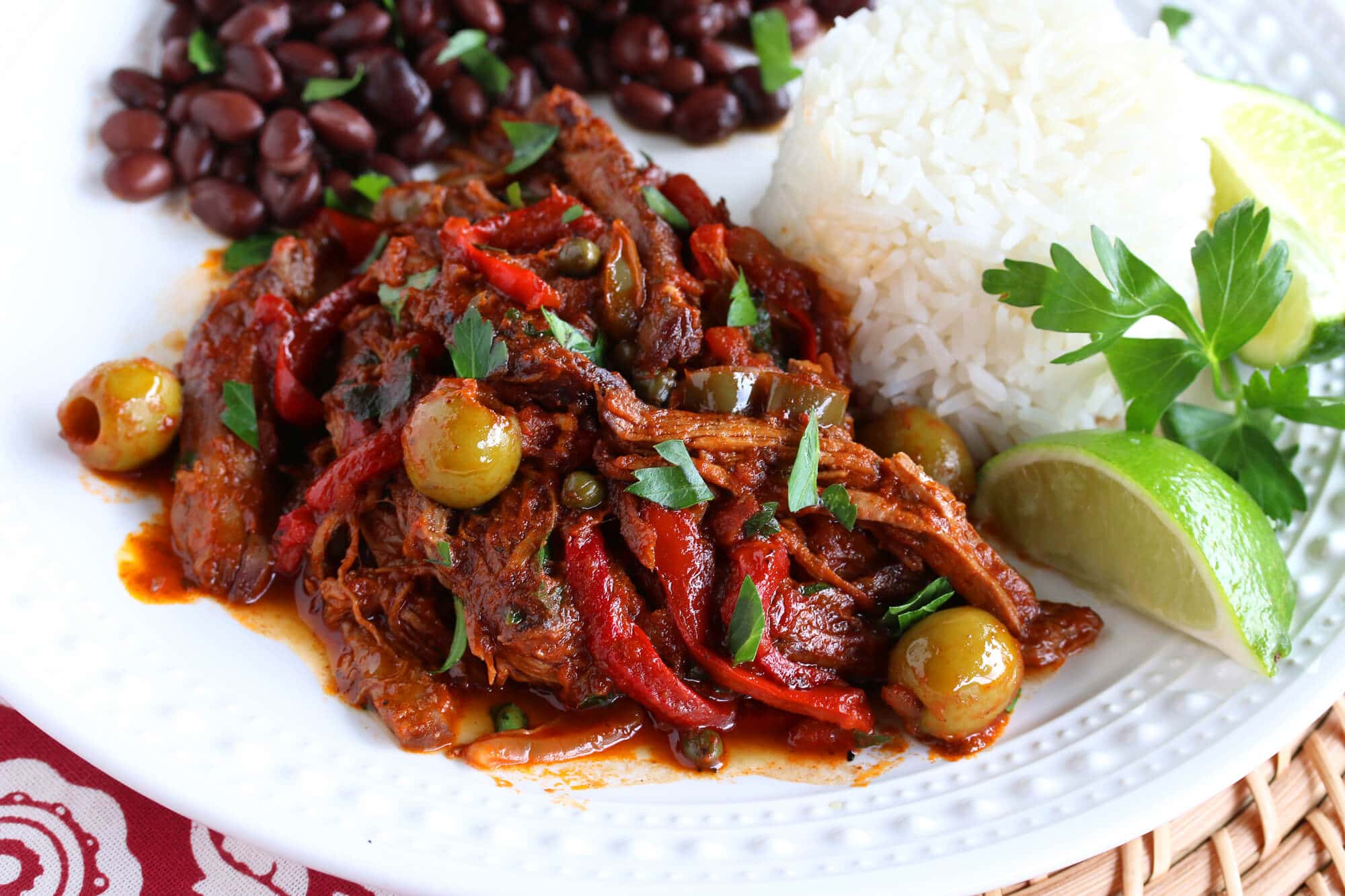
What is Ropa Vieja?
Shredded beef and vegetables that resemble a heap of colorful rags – that’s Ropa Vieja. From the Spanish term for “old clothes”, this is one of Cuba’s most popular and beloved dishes. So popular in fact that it’s one of the country’s designated national dishes.
This dish dates back to the Middle Ages of Spanish Sephardi, a loose adaptation of a dish that remains popular in southern and central Spain. Traditionally it was a way to stretch the leftovers of stews such as puchero or cocida, both of which are garbanzo-based dishes as is the original Spanish version of Ropa Vieja. This dish was later taken to Cuba where the Cubans made it their own.
Central in this dish are beef and tomatoes, both naturally umami-rich ingredients. Added to that are zesty bell peppers, caramelized onions, and to that we’re going to add some additional ingredients and spices that will make your taste buds sing with joy!
How to Make Ropa Vieja
Today we’re going to make some ultimate Ropa Vieja with a wonderfully rich depth of flavor! In the end you’ll have to make your own judgment call, but I’m pretty confident you’re going to love it (just check out the hundreds of rave reviews below)!
The traditional method for making ropa vieja involves simmering the beef in water, shredding it, and then adding it to the sauce. I’m going to show you a shortcut that not only saves time but results in a more flavorful dish. We’re going to sear the beef and then simmer it directly in the sauce, then shred it. This way all those flavorful juices from the beef go directly into the sauce. And it saves time. It’s a win-win. To mimic the extra step of making a separate stock, we’re also going to add whole carrots, celery and bay leaves and then discard them at the end, infusing the sauce with some umami qualities and natural sweetness from the vegetables.

Ropa Vieja Ingredients
For our ultimate ropa vieja recipe we’re adding an array of other classic Cuban and Spanish ingredients such as olives, pimientos and capers. In addition to the red bell pepper that’s caramelized with the onions, we’re also going to add roasted red bell pepper in the end for added smokiness, sweetness and flavor.
You may be wondering, “what’s the difference between pimientos and red bell peppers? Aren’t they the same thing?” A pimiento, also called pimento or cherry pepper, is a variety of red chili pepper that is sweeter and more aromatic than red bell peppers (though some varieties of pimientos are hot). They add a nice element of natural sweetness and flavor to this dish.
What is the Best Cut of Beef to Use?
Traditionally Ropa Vieja is made with flank steak. Have a look around the internet at all the ropa vieja recipes and virtually all of them call for flank. That piqued my curiosity because here’s the thing: Flank steak is from the bottom hard-working muscle area of the cow (ie, very lean/very little fat) so it not only has less flavor than some other cuts of beef, it’s also notoriously tough.

Because of its low fat content, flank steak is best suited to very quick, high heat cooking, like grilling. It’s not the best choice for braising or slow cooking because without the fat content and connective tissue it dries out during the cooking process. For all of these reasons flank steak used to be one of the cheaper cuts of beef. But in recent years the price has sky-rocketed and in many places is double the cost of chuck. But flank still continues to be used in nearly all ropa vieja recipes out of tradition because of its shape – the grains of the cut yield long strands of shredded beef resembling the dish’s namesake, torn clothing.
Flank steak is unique in that respect with those long tough strands. But I wasn’t willing to sacrifice tenderness, flavor or cost for the sake of having long shreds of beef. So I went to three different butcher shops and chatted with their butchers. First I wanted to see their reaction when I told them I was looking for flank steak for a low and slow-cooked dish. All three raised their eyebrows and asked me why on earth I’d want flank steak for that. They all shook their heads and said that, hands down, the best choice for slow-cooked shredded beef was chuck. Better texture, better flavor and at nearly half the price of flank.
Chuck works so well for slow cooking because the long cooking time over low heat breaks down the cartilage, melts the fat and keeps the beef moist while also adding a ton of extra flavor. It’s by far the most popular beef cut of choice for slow cooking and shredding. So what about the aesthetics element, those long strands of beef you get from the flank steak? Chuck has short strands that after slow cooking and shredding typically look less pronounced and are mushier. The way around that: Simply ask the butcher to cut you a piece of chuck that is taller than it is wider (the height running with the direction of the grains). That way you’ll get longer strands along with a deliciously flavorful, tender and moist shredded beef.

Can I Make it in a Slow Cooker?
Yes! You’ll still want to sear/brown the roast first because this is essential for the best flavor. Likewise follow the instructions to saute the veggies. Then transfer the ingredients over to the slow cooker and cook on LOW for 6-8 hours or on HIGH for 4-6 hours or until the beef is tender. Remove the veggies and bay leaf and follow the instructions in Step 3 to add the final ingredients.
Can You Freeze It?
Yes! Ropa vieja freezes well. Freeze it in a freezer-safe container or freezer bag for up to 3 months. Remove it from the freezer, let it thaw in the fridge overnight, and slowly reheat it on the stovetop, in the oven, the microwave, or slow cooker.
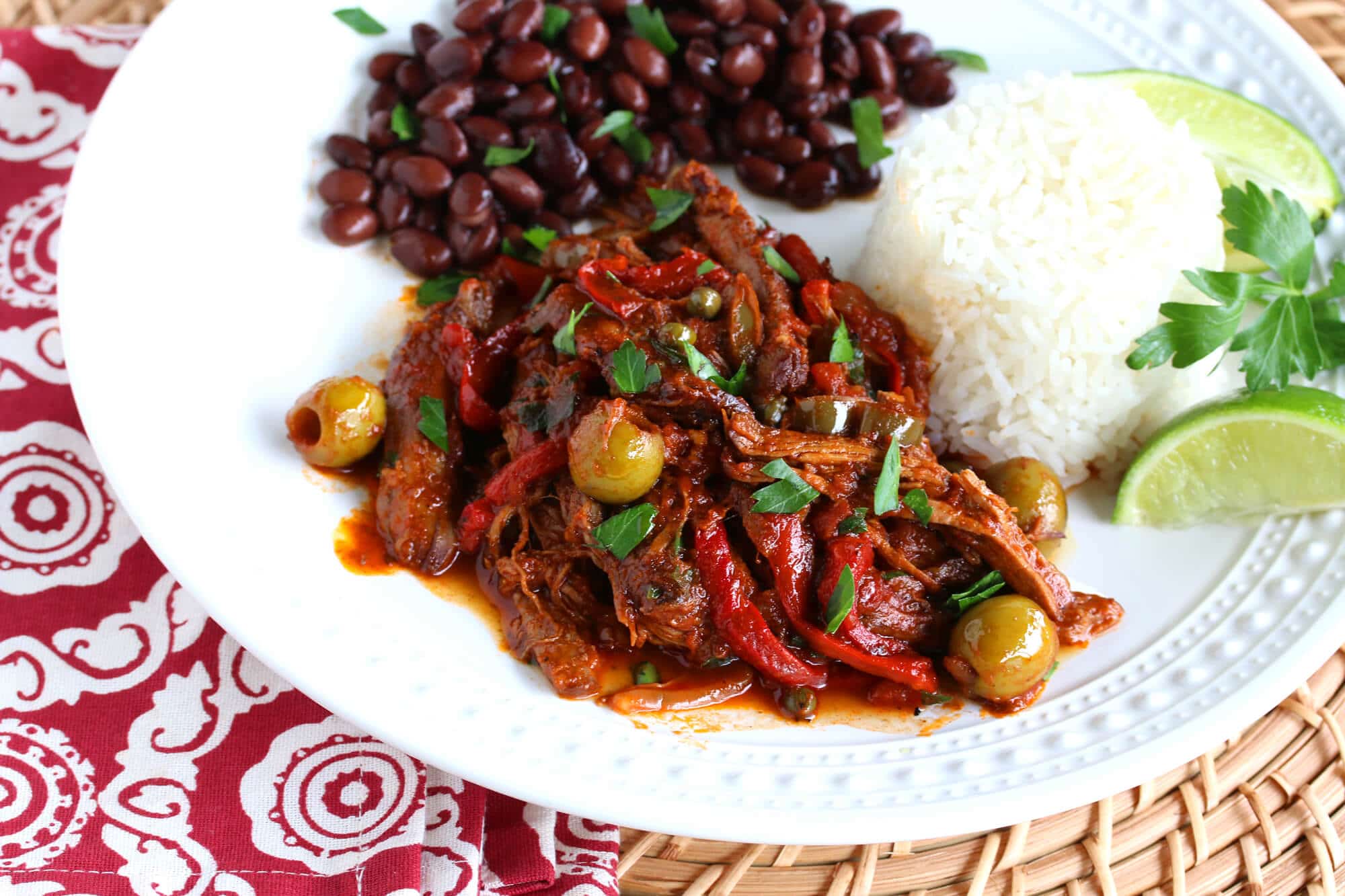
Ropa Vieja Recipe
Let’s get started!
Pat the beef dry and sprinkle with salt and freshly ground black pepper. Heat the oil in a Dutch oven over high heat. Once very hot add the beef and brown generously on all sides. I’m using my Le Creuset Dutch oven. I also have the Lodge Dutch oven that is a fraction of the price and I love them both.
Transfer the beef to a plate. Do not discard the drippings and blackened bits in the pot, they are key to the flavor.
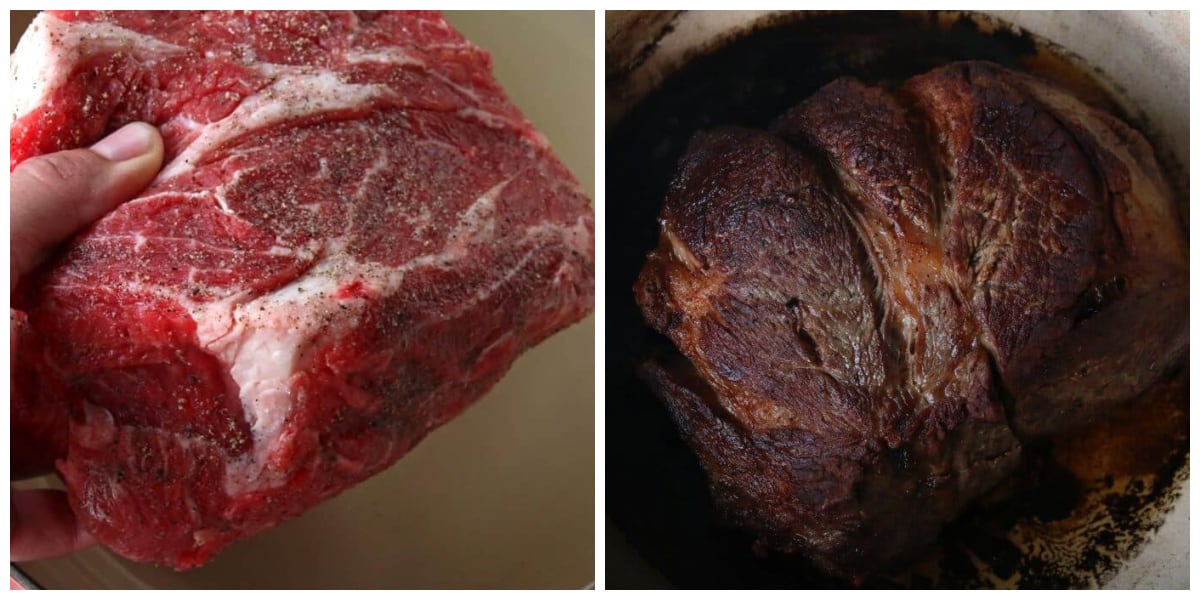
Add the sliced vegetables to the pot and cook over medium heat for 15-20 minutes until caramelized.

Add the garlic and spices and cook for another minute.
Add the white wine and bring it to a rapid boil, deglazing the bottom of the pan (scraping up the browned bits on the bottom of the pan).

Add the broth, crushed tomatoes, tomato paste and bay leaves. Simmer for 5 minutes.
Return the roast to the pot along with the pieces of carrots and celery. Bring to a boil, reduce the heat to low, cover and simmer for 3-4 hours or until the beef is fork tender and falls apart easily.
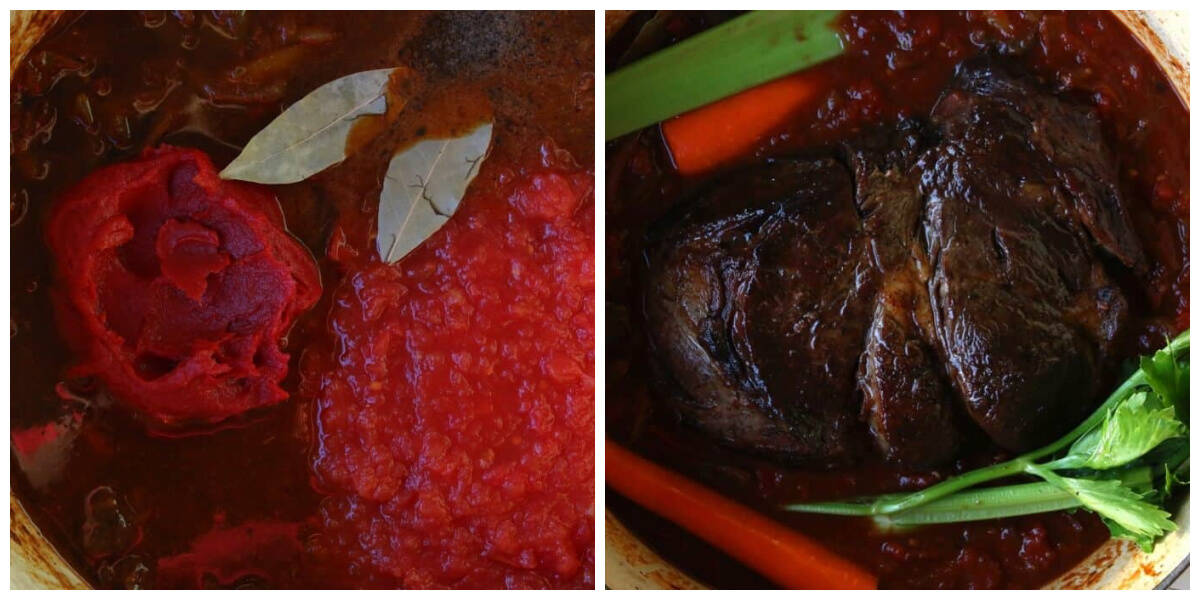
Discard the celery, carrots and bay leaves.
Transfer the beef to a plate and shred it with two forks.
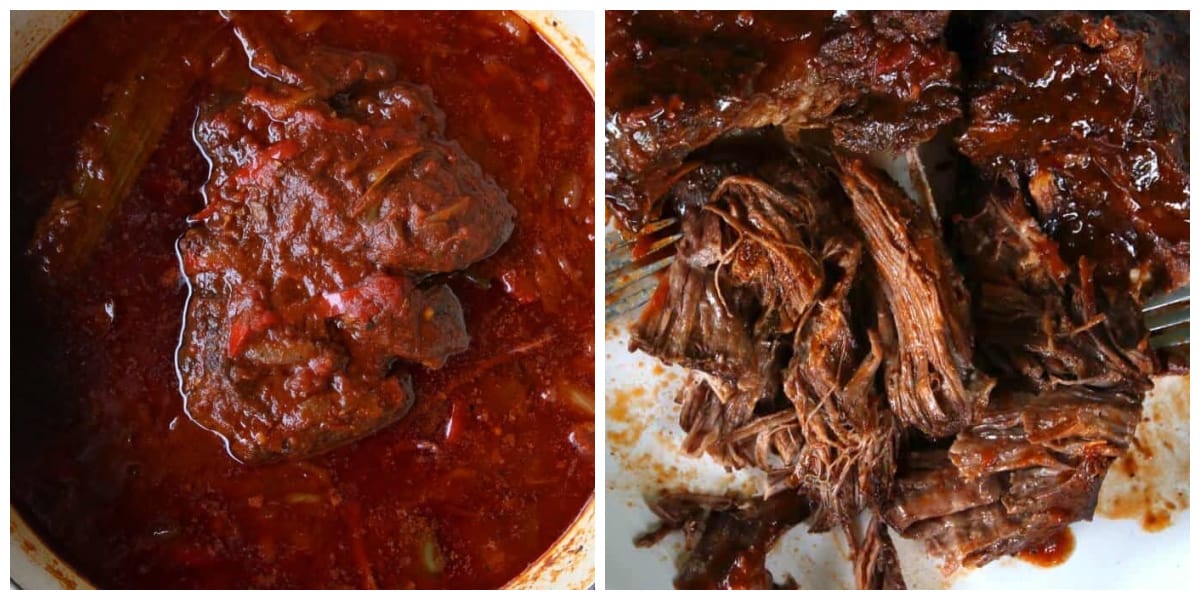
Return the shredded beef to the sauce. Stir in the olives, roasted red peppers, capers and pimientos. Simmer uncovered to thicken the sauce for 30 minutes.
Stir in the parsley. Add salt and pepper to taste.
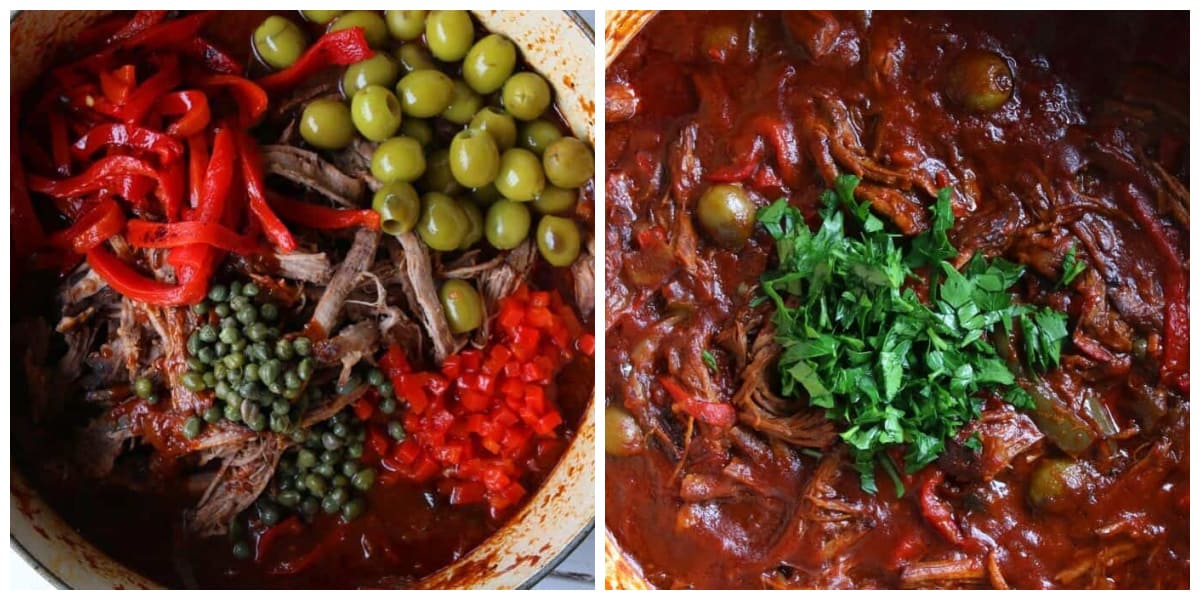
Your Ropa Vieja is ready to serve.
And its flavor only improves the next day if you can be patient enough to wait!
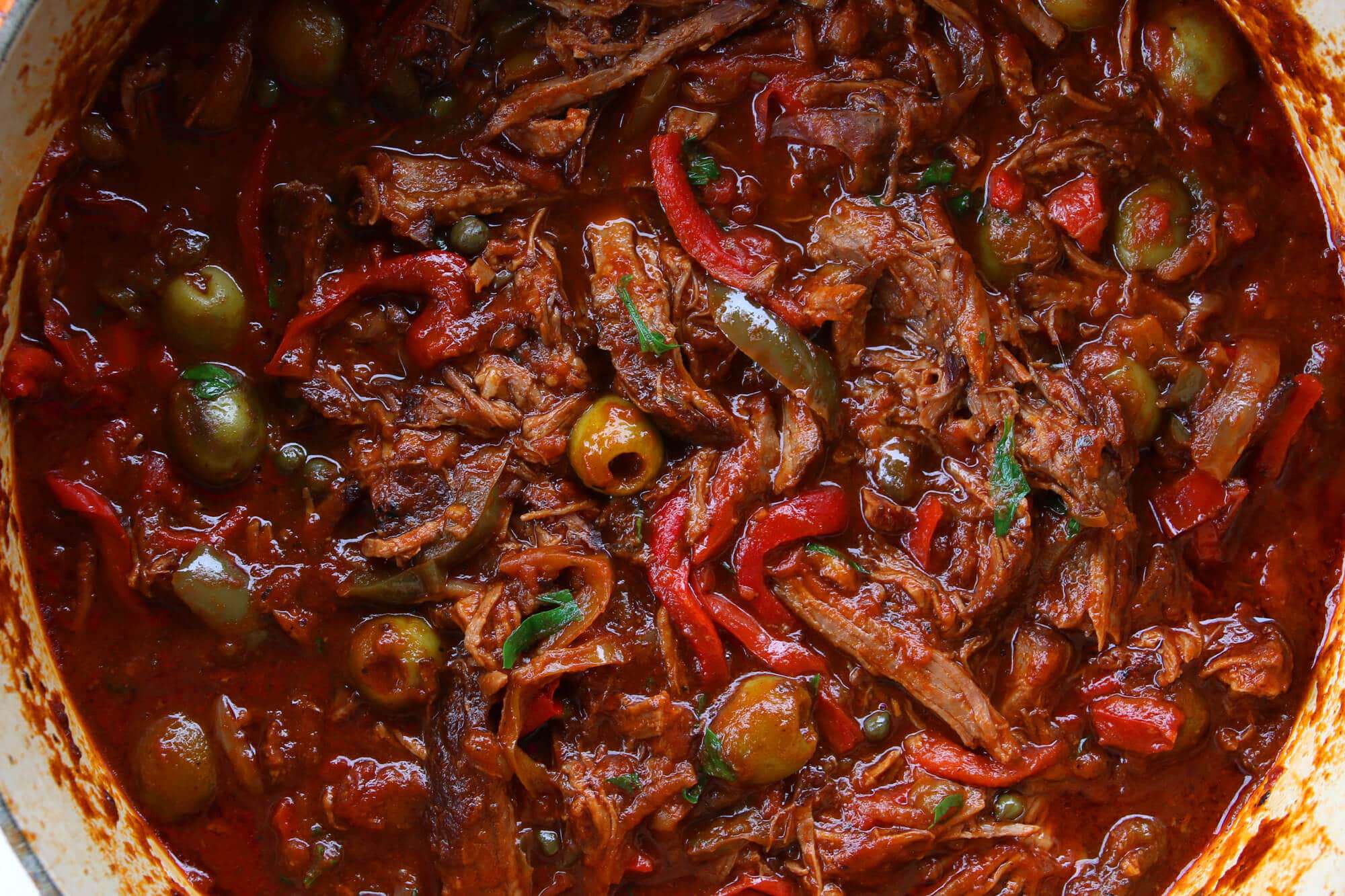
Serve with steamed or yellow rice and black beans. And for an additional treat, include some crispy homemade Tostones!
Ropa Vieja only tastes better the next day as the flavors have more time to meld, so this is a perfect dish to make in large batches for leftovers!
Enjoy!
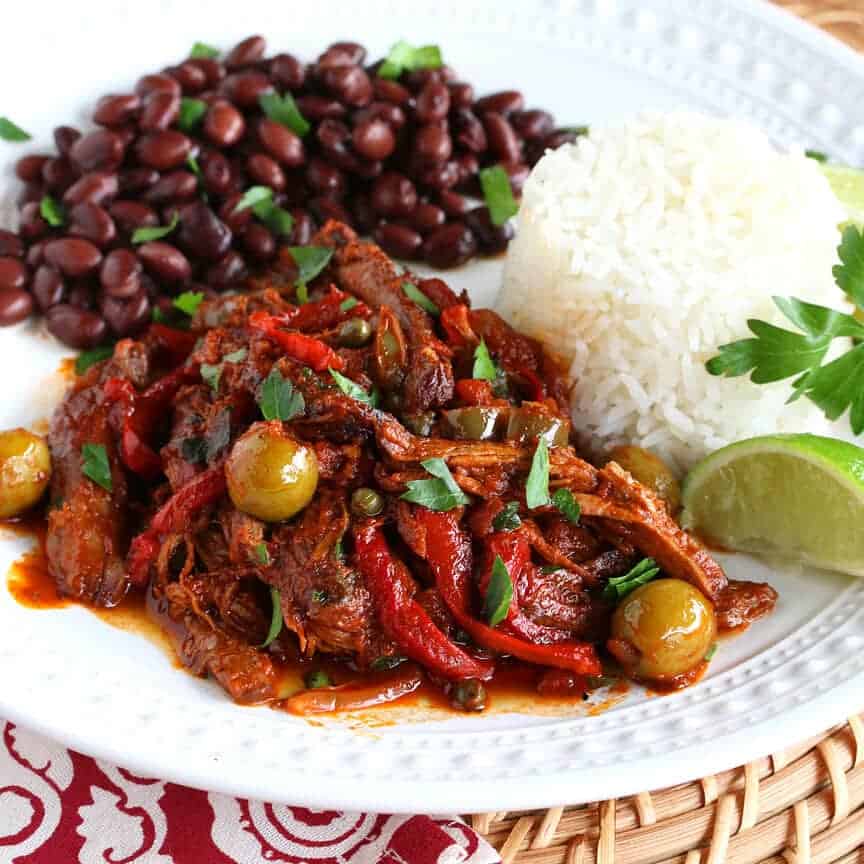
For more incredible beef stews from around the world be sure to try my:
- Guinness Stew
- Hungarian Goulash
- Sega Wat (Spicy Ethiopian Beef Stew)
- Pörkölt (Hungarian Beef and Onion Stew)
- German Goulash
- BEST Beef Stew
- Pichelsteiner
- Beef Bourguignon
- Hachee (Dutch Beef and Onion Stew)
- Domoda (Gambian Peanut Stew)
Save This Recipe
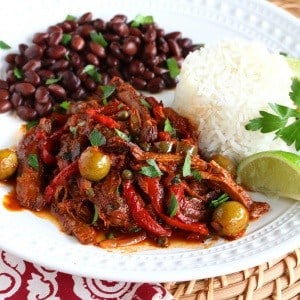
Ultimate Ropa Vieja
Ingredients
- 2 pounds chuck ask your butcher to cut it taller than wider so you get long strands of beef along the grain. OR you can use flank steak (see discussion in this post about cuts of beef and why we recommend chuck over flank)
- 1 large yellow onion thinly sliced
- 1 of each large green red and yellow bell pepper, thinly sliced
- 4 cloves garlic minced
- 2 teaspoons dried oregano
- 2 teaspoons ground cumin
- 2 teaspoons sweet paprika
- 1 teaspoon smoked paprika
- 1/8 teaspoon ground allspice
- 1/8 teaspoon ground cloves
- 2 teaspoons kosher salt
- 1/2 teaspoon freshly ground black pepper
- 1/2 cup dry white wine
- 1 cup chicken broth
- 16 ounce can crushed tomatoes
- 6 ounce can tomato paste
- 2 bay leaves
- 1 large carrot cut in half
- 1 large stalk celery cut in half
- 1 cup green olives , rinsed and drained (you can slice them if you prefer)
- 1/2 cup roasted red peppers , drained
- 1/4 cup pimientos , drained
- 2 tablespoons capers , rinsed and drained
- 1/3 cup chopped fresh parsley
Instructions
- Pat the beef dry and sprinkle with salt and freshly ground black pepper.Heat a little oil in a Dutch oven over high heat. Once very hot add the beef and brown generously on all sides. Transfer the beef to a plate. (Do not discard the drippings and blackened bits in the pot, they are key to the flavor.)Add the sliced vegetables to the pot and cook over medium heat for 15-20 minutes until caramelized. Add the garlic and spices and cook for another minute. Add the white wine and bring it to a rapid boil, deglazing the bottom of the pan (scraping up the browned bits on the bottom of the pan).Add the broth, crushed tomatoes, tomato paste and bay leaves. Simmer for 5 minutes.
- Return the roast to the pot along with the pieces of carrots and celery. Bring to a boil, reduce the heat to low, cover and simmer for 3-4 hours or until the beef is fork tender and falls apart easily. Discard the celery, carrots and bay leaves.
- Transfer the beef to a plate and shred it. Return the shredded beef to the pot.Stir in the olives, roasted red peppers, capers and pimientos. Simmer uncovered to thicken the sauce for 30 minutes. Stir in the parsley and add salt and pepper to taste.
Notes
Nutrition
Originally published on The Daring Gourmet June 27, 2016



















Can’t wait to try this—your recipes (country to country) are always a hit. Thank you ever so much. You make your followers stars in the kitchen.
Thanks, Barbara, I appreciate that! :)
Yum! This is just oozing with flavor!!!
I had a hard time finding a whole chuck roast in Japan. It has to be preordered from my butcher. My favorite butcher suggested using wagyu beef shin because I couldn’t wait. I also had to roast my own peppers because Lindsay products are also hard to find in Japan. As for the pimientos, I had no choice but to use the sweetest fresh red bell pepper I could find. And since I love olives (I know what I like), I think I made a nice choice. So anyway, anyway, I made this the other night and it was so delicious! My husband and I almost ate the whole pot. It goes so well with newly cooked Japanese rice too. The meat just melted in our mouth. Oh, and to think I almost didn’t buy limes! What a wonderful surprise. This recipe is a treasure, thank you for sharing it. Love, love love.
I am absolutely thrilled to hear that, Margot! And seriously, are you trying to make us all jealous with that Japanese wagyu beef?? :) I really appreciate the feedback, thank you!
Discard the carrots and celery ? Cooks treat surely 😊. I will give this a go with Thai beef and let you know ! Can’t wait actually. Best wishes.
That’s great, Paul! Let us know what you think. And yes, cook’s treat for sure :)
If you actually read your wikipedia reference, you would surely note that it is a Spanish dish! How many times have you eaten in Cuba?? None, because you were not allowed to go there. Pity!
Of course it’s of Spanish origin, Frank. After all, Cuba was colonized by the Spaniards. Much of Cuban cuisine is influenced by the Spanish and Ropa Vieja, Cuba’s national dish, is one example.
FYI…I am married to a Cuban and have been with “real” Cubans not on resort…in Cuba at least a dozen times. “Real Cubans” do make Ropa Vieja in Cuba despite not much availability of beef and do in fact have access to spices and herbs to make very flavourful and delicious food.
Thanks for confirming, Ann.
It is a Cuban dish when made this way specially with the flank steak. Cuba was there much before the harsh conditions faced now. And this dish was a very common “Pre-Castro” Cuba. Unfortunately, you don’t see it much now, except on special occasions, due to the scarcity of the ingredients. Whenever a cook has some of the ingredients, others won’t be found. Maybe has the onions, but can’t find the peppers, or the wine or the oregano, etc, etc. And on rare occasions when meat is found, it is promptly made with whatever is on hand. Thanks for showcasing this delicious Cuban dish.
Thanks for sharing these insights, Zenia.
Referencing your comment to Kimberly – I cant say if she was or wasnt allowed to visit Cuba, but Im 5th generation Cuban – BORN in Havana! Your comments only show your ignorance…No matter how many times YOU say you’ve been there! – And, that being said, and judging by your comments – YOU, have NEVER tasted Authentic Cuban Cuisine ..
I can respectfully assure you, that this is not “the” or “a” national Cuban dish, good as it sounds! It is a very rare time when Cubans have meat! Black beans and rice is the staple and seldom do they incorporate spices into their dishes, certainly, never a bay leaf, or cumin and even oregano is a stretch!!!!Perhaps you are referring to the “Miami” Cubans-which is still very suspect.This is a Spanish-origin dish,and as such, to claim it to be the Cuban national dish is simply absurd! Love the Cubans, been there at least eight times, Meat and spices are not their forte! Still an excellent recipe, but not Cuban.
Hi Frank, with all due respect, I don’t know where you were dining out or who you were talking to the last eight times you were in Cuba but not only is Ropa Vieja Cuban, it is quintessentially Cuban: It’s the country’s national dish. (See https://en.wikipedia.org/wiki/National_dish and hundreds of other references if you Google it.)
Thank you Kimberly! My sentiments exactly! – And I’m 5th generation Cuban – born in Havana! (Left after Fidel came into power..) Have a fabulous day, and enjoy your “Flavorful Ropa Vieja!”
I think you are misunderstanding “National Dish” Our National dish was fish and chips. Does not mean we ate it at every meal. Its the dish UK was traditionally noted for. Currently Curry is considered the National dish and that certainly did not originate in UK.Google also agrees with Kimberley.
Happy tasting Paul.
Paul, I lived near Cambridge for 7 years and oh, how I miss those curries and Indian restaurants! And my husband regularly pines for good fish & chips and Cornish pasties (he’s very proud of his Cornish ancestry). I try to keep him content by making them at home but I know as soon as we set foot off the plane the next time we’re in England he’ll be running to the nearest chippy :)
Hello Frank Mosher,
I respectfully beg to differ with regards to Cubans not using a lot of spices/meats in their cooking…I’m assuming the 8 times you were there was much more recent and long after Fidel assumed power…Take this from a 100% Cubana – born in Havana – forced to leave our beautiful Island in 1963 when I was four..several years after the Communist Tyrant took over, with my Mother, Father, both Grandmothers (who absolutely loved to cook!) ..and would tell you that “Authentic Cuban Cuisine” is some of the most flavorful cuisine one can ever taste! You’re correct that for close to 60yrs,during the rein of Fidel, Cubans that remained had practically no meat, (when they did it was rationed) and practically NO spices..(embargos etc) but prior to his taking over – and you can ask ANY Cuban and they will tell you that Cuba was not only one of the richest,most beautiful Isles in the world – but that the flavors of our dishes screamed spices! It was where the wealthy vactioned for many many years. Just wanted to clarify and educate a little bit..When you speak of the “Miami Cuisine” – you’re probably correct in that a lot of the dishes have been “Americanised” (kinda like “Taco Bell is the furthest thing from “Mexican food out there) – but you can still find Authentic Cuban Cuisine out there..usually your “hole in the wall” family owned restaurants. I have actually lived in CA since my family had to flee, and Ive found several “Authentic” Restaurants out here..(the majority of my family however did relocate to Miami..(a few good restaurants there as well – Growing up and after my daughter was born we visited family every year..I’ve been blessed to have had my maternal Grandmother until she passed at 89yrs, my Paternal Grandmother until 100yrs of age, and my Mother who is still living, driving, lives on her own tho close by and she will be 88 in Dec. – their influence and guidance have been my teachers in the kitchen..and YES, ABSOLUTELY, “Ropa Vieja” is our National Dish along with black beans and rice (and when made by a Cuban, tastes NOTHING like the “canned variety”..they are much more flavorful and “Oregano” is key..I am 57yrs old and remember my history and my roots and have been the “cook” whenever my Father (RIP – we lost him due to a botched surgery) brothers, sister, etc craved some good “homestyle” Cuban Food..Ropa Vieja, Picadillo, Lechon, etc.have always been at the Top of the list, and THIS recipe is about as close to the “real” thing as you can get..INGREDIENTS are VERY Authentic…and one last thing…you are also correct in saying Ropa Vieja has “Spanish” influence – it WAS Christopher Columbus who first layed eyes on Our Tropical Island – and his words were “this is the most beautiful place on earth”..back in the late 1400’s..of course, we all know where he was from. For you to say that Cuban Cuisine is lacking in flavor or spices, simply shows that you my friend, have NEVER tasted “real” Cuban food, and it sounds as silly as saying Cubans don’t like “new cars” and like to live in shacks, never upgrade their Hotels etc etc. because when you visit it’s like going back to 50’s..LOL! It’s called embargos, and a tyranical communist as their leader…bring out your history books, or better yet, google it! (I’m sorry for such a lengthy story, I tend to get annoyed when people make silly comments without knowing what they’re talking about.) I’ll get off my soapbox now…God Bless America! I am very proud to be an American – A Cuban-American.
.
Thank you Maria, for this wonderful contribution. Not the soap box, but exactly the fine explanatory essay should sound! I really enjoyed it. –Was looking for a marzipan recipe and discovered this mind spinning blog – thank you Kimberly! — The reason that I clicked on the Ropa Vieja recipe (enlightening or adding to the discussion) is that I view it as a Canarian dish! :-) Columbus set off from Gran Canaria (I know as I visited Casa de Colon in Las Palmas), but whether it was Canaries who influenced the Cubans, or the Cubans who influenced back the Canaries, I don’t know! :-) A simpler version of la ropa vieja that I tried on Tenerife included meat,potatoes, chick peas, onions and peppers, not the olives and capers. This recipe sounds and looks powerful and exciting, especially combined with black beans and white rice for contrast. Powerful in the sense of ‘protein rich’. This kind of stuff will get you through life to your 90s and 100s! Bless you both….
Thank you, Maria and Sonja :) Yes, this dish originated in Spain in the Middle Ages, also popular in the Spanish Canary Islands. It was later brought to Cuba when the country was colonized by the Spaniards, but the Cubans very much added their own touch and influence to dish. Happy eating! (P.S. I just made a batch of marzipan this weekend to make some pastries but have to make another batch because it somehow all got nibbled away ;)
I just got back from Cuba. I ate ropa vieja in a private home and they told me that it is their national dish. While beef is difficult to get, pork and chicken are staples. They made ropa vieja with shredded pork served over pureed plantains. Other than the olives, the spices and ingredients look the same as the ropa vieja I was served. It was delicious.
Frank being born in Cuba I can assure you are dead wrong. Lol the only reason Cubans might not have any meat or spices right now nownis cause of the government making everyone poor af. Your post is the most ridiculous thing I’ve ever read. It’s like saying Japanese people don’t make sushi 😂
Suzi, you have just made my point. i.e. no meat or spices, regardless of whether it is because of the embargo or their own government system. There are some arguments to be made that Fidel took that country out of sheer poverty, and at least took it back from American corporations!!! That was a long time ago-perhaps the present system is not motivating anymore, in fact it is not! BUT, no one goes hungry, free eye laser surgery, free medical, free education for all! Can you find another Caribbean country that offers that-no! In fact the US does not either.
This sounds so fantastic I cannot make it soon enough…thank you for sharing all of it’s history and the methods prior to yours….will let you know how it comes out…The pictures make one want to chew on the pages…
Very truly Yours,
Morgan Lewis
Thanks, Morgan :) I just made it again this past week and tried it with chicken this time, also super delish!
Absolutely great post, I loved learning about the beef parts. And the pictures are amazing, I am keeping this dish in mind, I would love to taste it soon.